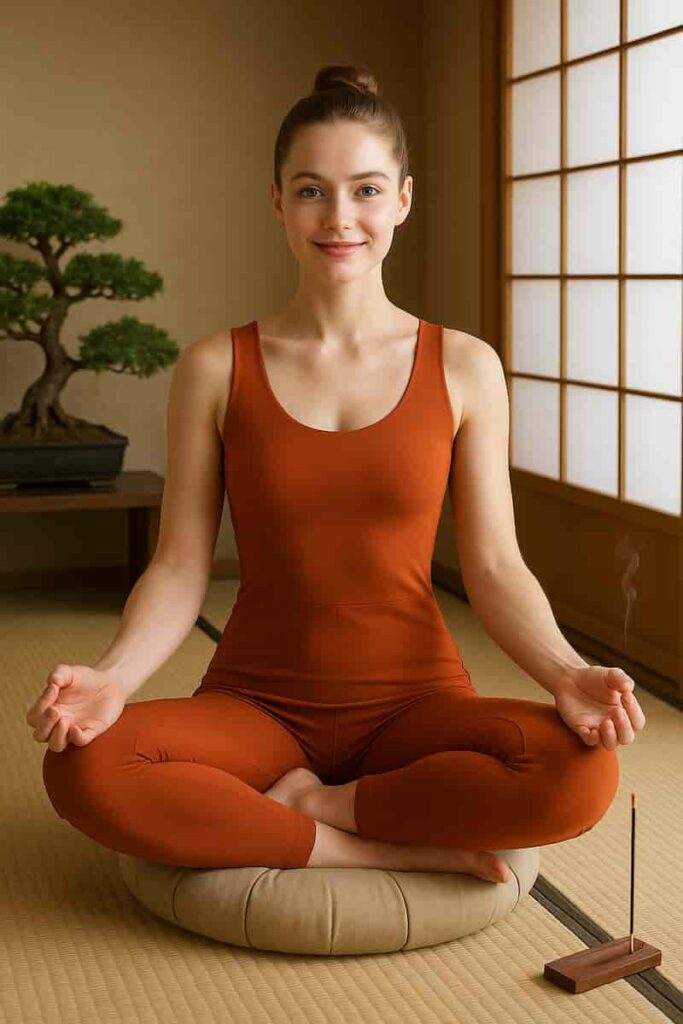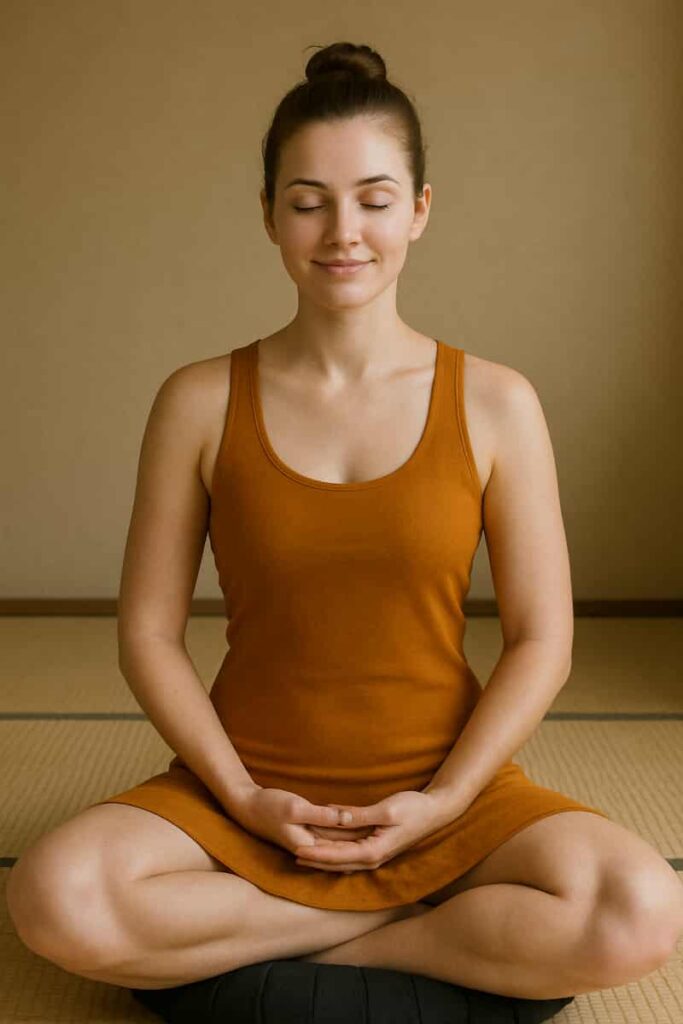
What is Zen meditation? Okay, imagine trying to sit still like a statue while your brain throws a tantrum about your to-do list, that awkward thing you said in 2012, and why your knee suddenly itches. That’s Zen meditation (or Zazen, if you want the fancy term). It’s not about floating into bliss—it’s about not chasing thoughts while you stare at a wall or your lap like it’s the most interesting thing ever.
Here’s the twist: You’re not doing anything. No mantras, no apps, just you and your stubborn mind. Sounds pointless? That’s the point! Zen strips away the fluff—no “self-improvement” hustle, just sitting there until you realize calm isn’t something you find, but something you stop drowning out.
So why bother? Because life’s already loud. Zen’s like hitting pause on the mental noise. Don’t worry, you’ll suck at first (everyone does). But if you stick with it, you might notice tiny shifts—like pausing before raging at traffic, or actually tasting your coffee instead of gulping it like fuel.
What Makes Zen Meditation Unique?
Alright, let’s cut through the mystique. First things first, Zen meditation isn’t about levitating or suddenly understanding the meaning of life. Instead, it’s about doing the hardest thing ever: sitting still and shutting up. Sounds simple? Just wait—your brain will hit you with a highlight reel of every embarrassing thing you’ve ever done within minutes.
Now, here’s the scoop. Zen started in China (where they called it Chan) and then got polished in Japan. But here’s the kicker: it doesn’t care how smart you are. In fact, it actively ignores your brilliant thoughts. Think of it like trying to hold a squirmy cat—the more you chase “enlightenment,” the more it escapes.

So How Do You Actually Do It?
Let’s break it down:
- Sit like you mean it—on a chair, cushion, or floor. No need for pretzel legs unless you’re into that.
- Watch your thoughts like clouds—not grabbing them, not judging them, just “Oh, there’s that weird dream again… moving on.”
- Breathe like it’s your job—because honestly, when your mind starts ranting about your ex or your grocery list, that breath is your lifeline.
Here’s the thing: other meditations might say “notice your feelings” or “focus on gratitude.” But Zen? Nope. It’s more like “Stop picking at your mental scabs and just sit.” At first, this feels pointless. Then, if you stick with it, you realize the magic isn’t in doing—it’s in not doing.
Of course, you’ll fail. A lot. Your back will ache. Your mind will throw tantrums. But guess what? That’s the practice. Zen isn’t about perfection—it’s about showing up, again and again, even when it’s boring or hard.
Bottom line? If you’ve ever wished your brain had an “off” switch, Zen is the closest thing to it. And hey, if you fall asleep, welcome to the club—even monks do it.
🌿 Benefits of Zen Meditation
The Magic of Zen Meditation – Simple, Science-Backed, and Super Practical
Zen meditation might sound ancient and mysterious, but guess what? It’s not just for monks hiding in mountains. Modern science says it’s awesome for your brain, emotions, and even your stressed-out soul. And don’t worry—you don’t need to sit like a pretzel for hours.
A. Mental Clarity (Bye-Bye, Brain Fog!)
Zen helps you focus and clear the junk in your mind. Less mental noise = better decisions. (Perfect for when you’re staring at your to-do list, frozen like a confused penguin.)
B. Emotional Resilience (No More Drama!)
Instead of fighting thoughts or drowning in feelings, Zen teaches you to watch them—like clouds passing by. Result? Less panic, more peace. (“Oh, there’s my anxiety… Hey, look, a butterfly!”)
C. Stress Reduction (Chill Mode: ON)
Sit still. Breathe. Let your body switch from “OMG, I’m so busy!” to “Ahhh, I’m alive.” Science calls this the “rest and digest” mode. Your shoulders will thank you.
D. Spiritual Awareness (But No Woo-Woo Not a word)
Beyond just “fixing” yourself, Zen opens a quiet space inside. No flashing lights or weird chants—just you, some silence, and maybe a sudden “Oh… THAT’S life?” moment.
Pro Tip: “Sit for 20 minutes daily. Too busy? Sit for an hour.” – Zen folks (who clearly knew about our excuses).
So, why not try? Worst case: You get a nice nap. Best case: You become a calmer, wiser, less-reactive human. Not bad for just sitting there, huh?
How to Practice Zen Meditation at Home
So, you want to try Zen meditation? Good. No incense, no chanting, just you and a few minutes of not thinking about your to-do list. Here’s how to do it—without turning into a human pretzel.
1. Find Your Spot (No, Not the Fridge)
Pick a quiet place where you won’t be interrupted. Bedroom? Balcony? Floor behind the couch? Perfect. Just not the kitchen—unless you want to “meditate” on why you ate all the cookies.
2. Sit Like You’re the Boss (But Comfortable)
Use a cushion, a pillow, or a folded blanket. Sit cross-legged or kneel—whatever keeps your back straight without making you groan. Hands? Left palm on right, thumbs barely touching. (Yes, it looks fancy. No, no one’s judging.)
Pro Tip: If your legs fall asleep in 30 seconds, adjust. Zen isn’t about pain—it’s about noticing pain… and then moving a little.
3. Breathe Like It’s No Big Deal
Don’t force it. Just feel the air going in… and out. Your brain will interrupt (“Did I pay the rent?”). That’s fine. Just go back to breathing.
4. Let Thoughts Float By (Like Bad Text Messages)
Your mind will wander (“Why did I say that in 2017?”). Don’t fight it. Imagine thoughts like clouds—watch them pass. Then softly return to your breath.
Key Point: You’re not failing if thoughts pop up. You’re winning by not chasing them.
Final Advice: “Meditate 5 minutes a day. Too busy? Do 10.” (Old Zen joke. But true.)
Types of Zen Meditation (Zazen)
So you wanna try Zen? Cool! But heads up—not all Zen is the same. Different schools do it differently, kinda like how some people dunk cookies while others nibble (both get crumbs everywhere). Here’s the lowdown:
1.“Just Sitting” (Shikantaza)

- No focus. No counting. Just… sit.
- It’s like being a mountain – thoughts come and go, but you don’t chase them
- Warning: Your brain will scream “This is pointless!” That’s the point.
2. Koan Meditation (Rinzai Zen’s Mind-Bender)

- You wrestle with nonsense questions like “What’s your original face before you were born?”
- It’s designed to short-circuit your logical mind
- Pro tip: If you think you “get it”, you definitely don’t
3.Breath-Focused Zazen (Beginner-Friendly)

- Simply watch your breath (no need to turn into a human metronome)
- When your mind wanders to lunch plans, gently bring it back
- Like training a puppy: Patient, kind, but firm
Fun Fact: Zen masters argue about which method is “best”. Meanwhile, the real Zen move is not caring about who’s right.
Remember: There’s no “right” way – just your way. Unless your way involves checking Instagram mid-meditation. Then maybe rethink. 😉
Now go sit. 5 minutes. No excuses. (Said with love.)
Zen Meditation vs Mindfulness: What’s the Difference?
Look, meditation’s great – but all these terms get thrown around like they’re interchangeable. They’re not. Let me break it down like I’m explaining it to my coffee-deprived morning self.
Where They Come From
- Zen: Came from Buddhist monks who apparently loved sitting still more than standing in line at the DMV
- Mindfulness: The modern, Westernized version that says “sure, meditate at your desk if you want”
What You Actually Do
- Zen: You sit. That’s it. No goals. No “progress.” Just you, your cushion, and your racing thoughts about that awkward thing you said in 2012.
- Mindfulness: You notice stuff – your breath, sounds, how your left foot’s falling asleep – but try not to judge any of it
The Vibe
- Zen: Like a strict librarian – “Shhh! Just sit properly!”
- Mindfulness: Like your chill friend – “Hey man, whatever works for you”
Which Should You Try?
- If you hate instructions and want the simplest approach → Zen
- If you need some structure and like options → Mindfulness
Real Talk: They both work. Zen’s harder at first but gets deeper. Mindfulness’s easier to start but can feel a bit… unfocused.
Pro Tip: Try both for a week. Your brain will complain either way, so might as well experiment.
Now go sit before you talk yourself out of it. 5 minutes. Timer’s running… 😉
🔊 Guided Zen Meditation: Should You Use One?
Traditionally, Zen is all about sitting quietly—no instructions, no guidance, just you and your wandering thoughts. But let’s be real: if you’re new to this, sitting like a statue while your brain replays that embarrassing thing you did in 2012 isn’t exactly peaceful.
Guided Zen meditations can help—like training wheels for your mind. They set a rhythm so you don’t spend 20 minutes debating lunch options instead of meditating.
What to look for in a guide:
- Silence (not a chatty narrator who won’t stop talking).
- Posture reminders (so you don’t turn into a human pretzel).
- Breath focus (in, out… not “breathe like a dragon,” just normal breathing).
Some helpful resources:
- Yellow Brick Cinema – Soft music for silent meditation (no lyrics, just vibes).
- Zen centers on YouTube – Search for “guided Zazen” (avoid the ones with excessive whispering).
- A simple timer with soft gongs – No music, just gentle “ding” to keep you on track.
Pro tip: If you fall asleep, congratulations—you’ve achieved “advanced relaxation.”
Remember, Zen isn’t about being perfect. It’s about sitting down, shutting up (mostly), and not judging yourself when your brain drifts to pizza. Happy meditating!
📌 FAQs About Zen Meditation
Let’s be real—sitting still and not thinking feels weird when you start. Your brain will itch, your back will complain, and random thoughts like “Did I unplug the toaster?” will attack. But that’s normal! Stick with it, and soon, those quiet moments become your brain’s favorite reset button.
Nope! You can totally start solo—just sit, breathe, and try not to judge yourself when your mind wanders (it will). But if you want extra help later, local Zen groups or online communities are great. No mystical certifications required.
Start with 5-10 minutes. Seriously, no need to force a marathon session. Even Zen masters started small. If you last longer than your average TikTok scroll, you’re doing great. Slowly add time, but never torture your legs—comfort first!
Pro tip: If you finish and feel calmer than before, you’re already winning. If not? Try again tomorrow. Zen’s not a race—it’s practice for life’s chaos. 😊
Final Thoughts: Zen Is Simplicity in Action
Let’s cut to the chase—Zen doesn’t want you to “fix” yourself. No glow-ups, no productivity hacks, no chanting in a language you don’t understand. Just you, a cushion (or a chair—we don’t judge), and the wild idea of sitting still for a few minutes.
What You Actually Need:
- A quiet spot (even a closet works—desperate times call for desperate measures).
- Your breath (in, out… no fancy techniques, just air going where it always goes).
- A willingness to be present (aka not mentally rewriting that argument you lost in 2015).
That’s it. No apps, no incense (unless you really like the smell), and definitely no pressure to “achieve enlightenment” by Tuesday.
Wisdom from a Zen Master (Who Knew What’s Up):
“To study the Buddha Way is to study the self. To study the self is to forget the self.”
— Dogen (13th-century expert on chilling out)
Translation: Stop overthinking “who you are.” Just sit. Breathe. Let your thoughts pass like bad weather. The magic happens when you stop trying to force it.
🔗 Love mindful living? Follow us on Pinterest and LinkedIn for daily meditation tips, peaceful visuals, and more
🧭 Explore More on Yoga
Advanced Chair Yoga Poses for Strength & Balance
Chair Yoga for Beginners: A Complete Guide with Free PDF & 10-Minute Routine




